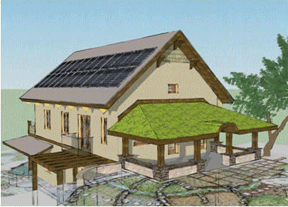By Maureen Halsema
Combining ancient building methods with modern science, a group of engineers and scientists are striving to change the world through structural design.
The goal: to create a carbon neutral home and increase the structure’s efficiency by 90 percent.
Welcome to the Nauhaus—a prototype home in Asheville, N.C., designed by the Nauhaus Institute, a nonprofit organization dedicated to developing sustainable building design and living solutions.
“We want to change how we build in this country,” said Jeff Buscher, Nauhaus Institute engineer and designer of the prototype home. “We think that there are a lot of opportunities for improvement and we have combined a lot of ideas to show people the way things could be.”
According to the design plan, the building would offset its own construction carbon footprint—with zero net energy. This means that the house would produce more energy than it consumes.
“In order to be carbon neutral, we calculate that the building will need to produce 200 percent more energy than it will use,” said Clarke Snell, managing director of the Nauhaus Institute. “We can do this with a six or seven kilowatt photovoltaic system.”
Incorporating renewable energy resources, implementing passive solar design and using high-efficiency appliances can also help accomplish this carbon neutrality feat.
A Liveable Space
At 1,700 square feet, the Nauhaus is smaller than the average American home. The interior space includes two bedrooms and one bath, and a one bedroom, one bath “mother in-law”apartment.
The smaller design is supplemented by the incorporation of 300 square feet of outdoor living space—such as the sleeping porch off of the master bedroom—that make the house feel larger and help facilitate air movement and natural lighting.
The smaller design also provides the property space needed to develop a garden and natural habitats for local wildlife.
“The idea is to blur the line where outside and inside meet,” Buscher said.
The house is designed to reduce water demands by implementing several water conservation measures, such as rain catchment, greywater irrigation and waterless composting toilets.
In order to reduce the environmental footprint associated with the construction of the house, many of the materials used in its construction are recycled or locally harvested, such as stone, salvaged brick and timber. The flooring materials are composed of compressed dirt from the site.
Pushing the Envelope
One of the fundamentals of passive solar design is to develop an efficient building “envelope,” to prevent energy loss from the home.
“The envelope is the skin of the house,” said Buscher. “It’s what separates the indoor condition space from the outdoors, keeping the weather out and the heat in.”
The Nauhaus team has insulated the house using a product called hempcrete, a unique combination of hemp chips—known as shiv (a waste product of hemp plants)—and a lime-based binder.
The Nauhaus prototype is one of the first houses built in the U.S. using hempcrete, which has a higher thermal resistance than that of straw bale construction or earthen mixtures. It replaces the need for traditional fiberglass insulation and drywall construction materials, creating a superior airtight envelope and enhancing the structure’s energy efficiency.
Hempcrete is known as water absorbent—it can absorb water vapor and hold it without rotting, then release the vapor back to the air when humidity levels drop, creating a breathable wall structure. This prevents mold issues inherent to some straw bale structures. The hempcrete’s increased response to humidity also improves indoor air quality.
Hempcrete is a flexible product that can be adapted for other uses, such as a soil. Hempcrete is not available in the U.S., however, and was imported from the United Kingdom for the project.
The Nauhaus concept seeks to turn the upfront cost of the house into long-term savings on utilities and maintenance. The designers hope to use the prototype as a learning model to demonstrate the financial, environmental and social benefits of the initial investment.
The house is open for tours every Saturday; visit TheNauhaus.com to sign up for a tour.
Related Articles
Latest News

Leave a comment
Your email address will not be published. Required fields are marked *






Leave a Comment